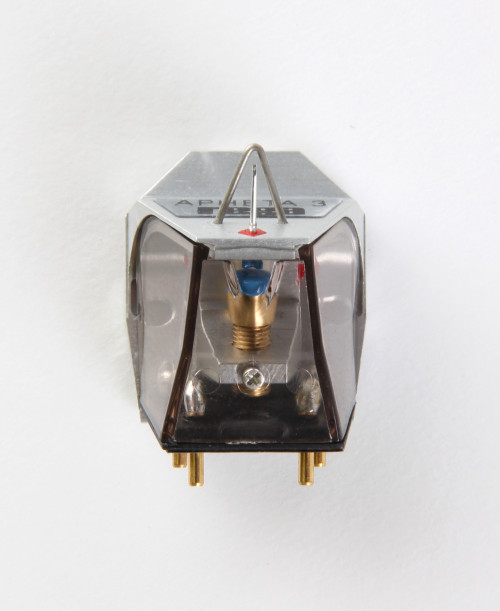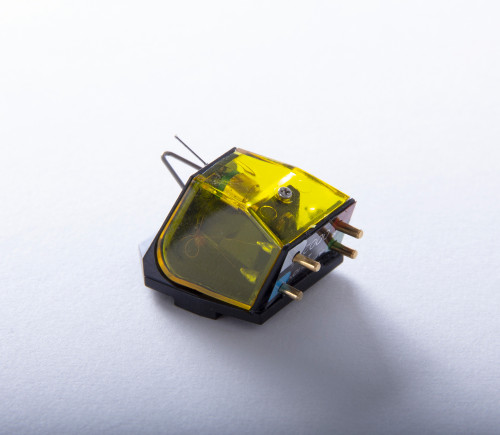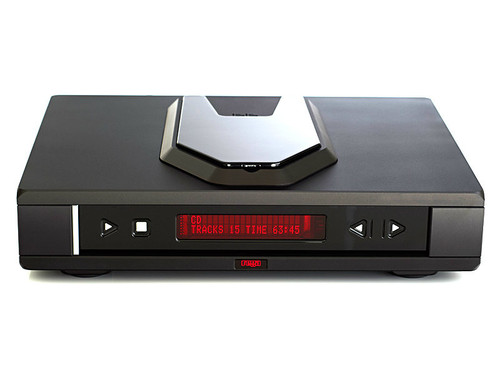The Rega Aura is a three stage, all symmetrical pre-amplifier. The first stage is a symmetrical, complementary class A amplifier, using parallel connected Linear Systems ultra-low noise FET (Field Effect Transistor) transistors configured as a symmetrical compound pair input stage. The use of FET transistors ensures there is no bias current flowing in the cartridge coil so as not to upset the delicate magnetic geometry of the cartridge. The input circuit configuration also alleviates the use of any coupling components between the cartridge output and the input stage FET transistors, which would degrade the sound. The complementary ultra-low noise FET transistors are carefully graded and matched for optimum performance. This stage drives the passive high frequency part of the RIAA equalisation stage.
The second stage is a symmetrical, class A, differential amplifier with a common base driver stage; this is also used as the active amplifier in the low frequency part of the RIAA equalisation stage. The third stage inverts the signal to provide the balanced output along with the output of the second stage; the third stage uses the same circuit topology as used in the second stage. The power supply is a symmetrical, discrete tracking power supply using fast diodes and a low noise voltage reference. Each stage has its own localised power supply and LED referenced current generators. To maximise headroom, the Aura has a power supply voltage, which is 60% higher than normally found in such a pre-amplifier. Very high quality, polypropylene capacitors have been used in the signal path. 1% tolerance polypropylene capacitors are used in the RIAA EQ stages and audio grade capacitors are used in the rest of the circuit. Gain, Mute and Mono switching is implemented using high quality relays.
Gain
Please note: mute or turn the volume control to minimum when changing the gain setting. The gain setting switch selects the voltage gain of the phono amplifier. Gain I selects 69.5 dB (switch out) and Gain II selects 63.5 dB (switch in); this will provide an input sensitivity of 67 μV and 131 μV respectively for an output level of 200 mV unbalanced and 400 mV balanced. The balanced output is effectively 6 dB higher than the unbalanced output. It is advisable to start with the lower gain setting II and if necessary, increase the gain level to I if more level is required for lower output cartridges. Because the balanced output is effectively 6 dB higher, it could be advisable to select gain II setting when using the balanced output; this will also depend greatly on the sensitivity of the connected amplifier.
Capacitance
There are five different input capacitance settings of 1000 pF, 2000 pF, 3200 pF, 4300 pF & 5700 pF. Select the required capacitance to match to that specified by the manufacturer in the cartridge specifications. It is permissible to try different loading conditions as sometimes changing the capacitance gives a different sonic performance more suited to your personal taste; this also applies if there is no loading capacitance specified by the manufacturer. To match some ‘legacy’ pre-amplifiers, select 5700 pF. The 1000 pF setting is optimised for the Rega range of MC cartridges.
Load Settings
There are five different input load settings of 50 Ω, 100 Ω, 150 Ω, 300 Ω & 400 Ω. Select the required load to match to that specified by the manufacturer in the cartridge specifications. It is permissible to try different loading conditions as sometimes changing the load gives a different sonic performance more suited to your personal taste. To match some ‘legacy’ pre-amplifiers, select 400 Ω. The 100 Ω setting is optimised for the Rega range of MC cartridges.
Mute
Allows you to mute the signal when changing the gain setting, in-between tracks or when changing records.
Mono
This function allows you to play mono recordings via a stereo cartridge.
General Conditions
Generator Source Resistance 20 Ω
(Audio Precision Z Out)
Load set to 100 Ω and capacitance set to 1000 pF (Apheta and Aphelion)
Output Load Resistance 100 kΩ
(Audio Precision Z In)
Input Sensitivity for 200 mV on Unbalanced Output
67 μV - 69.5 dB Gain Setting I
131 μV - 63.5 dB Gain Setting II
Gain Input to Unbalanced Output
63.5 dB Minimum
69.5 dB Maximum
Input Load
50, 100, 150, 300 & 400 Ω
Capacitive Load
1000, 2000, 3200, 4300, 5700 pF
Input Overload @ 1 kHz
9.6 mV - 63.5 dB Gain Setting
4.9 mV - 69.5 dB Gain Setting
Rated Output Level
Unbalanced 200 mV
Balanced 400 mV
Maximum Output Level
Unbalanced 14.5 V RMS
Balanced 29 V RMS
Balanced Output Connections
Balanced XLR connectors pin2 positive and pin3 negative.
The positive pin2 connection on the balanced output is the same connection as the unbalanced output.
Output Resistance
Unbalanced 100 Ω
Balanced 200 Ω
Absolute Minimum Output Load Resistance (for a –3 dB roll off @ 20 Hz)
500 Ω Unbalanced
1000 Ω Unbalanced
RIAA Accuracy (Better Than)
0.2 dB 100 Hz to 50 kHz
Frequency Response
13.5 Hz (–3 dB) to 100 kHz (–0.2 dB)
THD
Typically 0.03 % @ 1 V 20 Hz 20 kHz (Bandwidth 100 Hz to 22 kHz)
Output Noise Level (Unbalanced Output, A-Weighted and 15 Ω Input Load)
-77 dB V (69.5 dB Gain Setting I)
-82 dB V (63.5 dB Gain Setting II)
AC Supply
230 V & 115 V Nominal +/- 10 %
Power Consumption
15.3 W
"There’s a problem with the Aura, Steve. one song in and I never want to leave the house again. its massive sounding. really impressive. wow." - M Counts of Hawthorne Stereo
Read More about the Aura:
Not all products are always available at all retailers. If you're looking for a particular product, please call the retailer to check on available inventory.
















